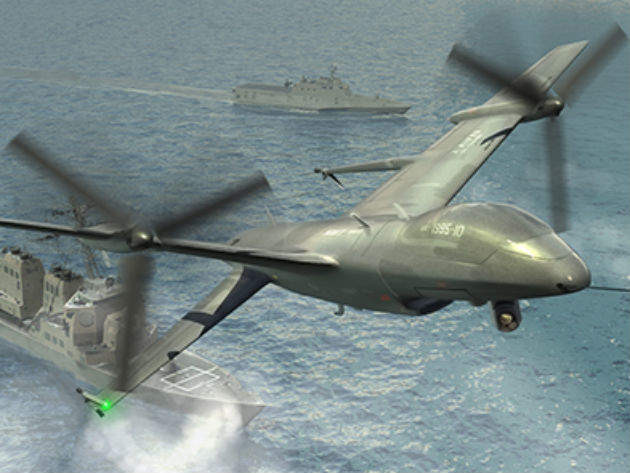

Greater intelligence, surveillance and reconnaissance (ISR) capabilities have long been on the wish list for smaller naval vessels, as the capabilities available to the largest vessels are often incompatible with ships of limited height above the water and limited deck space.

Discover B2B Marketing That Performs
Combine business intelligence and editorial excellence to reach engaged professionals across 36 leading media platforms.
The curvature of the earth limits what can be seen by radar and other electronic means, which is why they are often mounted as high as possible on a mast. While this works well for a destroyer, on a smaller ship it doesn't get you very far. Deck space is also at a premium on smaller vessels, or those not designed primarily for organic manned air assets (such as aircraft carriers) – both the crew and the aircraft take up to much valuable space on the ship.
It is for this reason that the US Navy, along with many other navies, has turned to unmanned solutions to increase the integrated ISR capabilities of its smaller vessels.
Scanning the skies
Initial steps were taken using Insitu's ScanEagle, which has been constantly updated over the years, for the smallest of vessels. Originally designed commercially for spotting good fishing grounds, the capabilities of the ScanEagle with its small launch footprint and wire capture method made it ideal for small naval vessels.
However, the US Defense Advance Research Project Agency (DARPA) and the US Navy's Office of Naval Research (ONR) are now looking at how to move beyond ScanEagle to larger, more capable UAS. The result is the Tactically Exploited Reconnaissance Node (TERN), a joint programme between the two organisations that entered phase three late last year. The stated aim is to provide "takeoff and land from confined spaces in rough seas and achieve efficient long-duration flight" as well as "other previously unattainable capabilities".

US Tariffs are shifting - will you react or anticipate?
Don’t let policy changes catch you off guard. Stay proactive with real-time data and expert analysis.
By GlobalDataThe first two phases of the project were focused on preliminary design and risk reduction and were achieved successfully according to DARPA. In the new phase, DARPA and ONR are planning to build a full scale demonstrator system of a medium-altitude, long-endurance UAS that can use forward-deployed small ships as a mobile launch and recovery sites.
"Initial ground-based testing, if successful, would lead to an at-sea demonstration of takeoff, transition to and from horizontal flight, and landing — all from a test platform with a deck size similar to that of a destroyer or other small surface-combat vessel," DARPA says.
In December 2015, DARPA awarded phase three of TERN to a Northrop Grumman-led team which also involves Scaled Composites, General Electric Aviation, AVX Aircraft Company and Moog. The total contract amount is $93m and Northrop Grumman is reported to be contributing $39m.
Increasing effectiveness
At the time of contract award, DARPA programme manager Dan Patt said: "The design we have in mind for the TERN demonstrator could greatly increase the effectiveness of any host ship by augmenting awareness, reach and connectivity. We continue to make progress toward our goal to develop breakthrough technologies that would enable persistent ISR and strike capabilities almost anywhere in the world at a fraction of current deployment costs, time and effort."
The design for the UAS is to be revolutionary and envisions a 'tailsitting', flying-wing configuration with twin counter-rotating, nose-mounted propellers. According to DARPA, the propellers would lift the aircraft from a ship deck, orient it for horizontal flight and provide propulsion to complete a mission. They would then reorient the craft upon its return and lower it to the ship deck. The system would fit securely inside the ship when not in use.
Speaking about the award, Northrop Grumman Aerospace Systems vice president for research, technology and advanced design Chris Hernandez said: "We believe our unique ship-based unmanned systems experience, expertise, and lessons learned from programmes including our MQ-8B/C Fire Scout, MQ-4C Triton, X-47A Pegasus and X-47B UCAS, is critical to the success of TERN."
Although Northrop Grumman is not releasing the finer details of its design at present, the full-scale demonstrator system, according to the company is "highly traceable to [the] operational concept to burn down risk, resulting in a compelling step forward for this game-changing, multi-mission capability".
Off the drawing board
DARPA and ONR are pursuing aggressive deadlines to get the third phase of TERN underway. In order to minimise risk wherever possible Northrop Grumman is opting for proven design solutions from its partners. A number of subcontracts have already been let, with Moog, for example, providing the complete flight control actuation system in less than twelve months.
The design for TERN has been likened by DARPA to the Convair XFY-1 Pogo developed by the US Navy in the 1950s. The Convair was an experimental ship-based VTOL fighter designed to provide air support for the fleet. However, despite successful demonstrations the aircraft never advanced beyond the prototype stage.
According to DARPA, that was in part because the navy, at the time, was focusing on fast jet aircraft and determined that pilots would have needed too much training to land on moving ships in rough seas. The advent of unmanned technologies means that this is no longer a hurdle for the development of this type of aircraft.
The US Navy has stated its goal of extending the reach, coverage and persistence of its naval ISR assets as it looks to strengthen its hold on the intelligence spectrum across all areas of the battlefield. TERN is likely to provide an interesting stomping ground for the development of these technologies that could prove game-changers to unmanned naval ISR.





